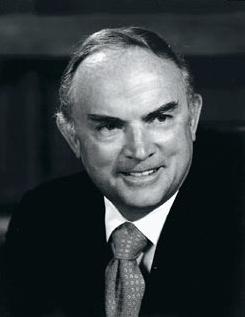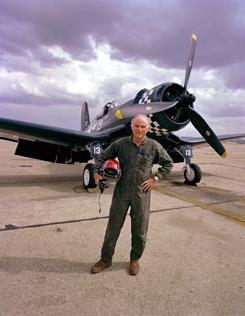Sometimes I wonder if us men these days can really live up to the great guys that have gone before us. I encourage you to read this, both as a compliment to personal development, our great guest speaker of 2010, Ed Foreman but mostly, to read about a man who was a pioneer of fighter Jets, aviation history and a real life action hero back in the day’s before silly celebrity status and sports stars modelling boxer shorts… In short though, I thought you might enjoy reading this over a coffee break, and hopefully, you will emerge from that coffee break wanting to live bigger!  One of the truly great leaders of the Aerospace Industry, William Paul Thayer, Chairman and CEO of LTV Aerospace Corporation. was as much at home in the cockpit of a jet fighter as he was in the presence of the giants of the business and military world. Taking over the reins of the LTV corporation when it was at its lowest ebb, he brought the organization from the verge of bankruptcy to a healthy, viable leader in its field. Dynamic, charismatic, tough, wily and friend to all of his employees, are but a few of the attributes that form his character. Paul has always been a winner. A Navy fighter ace in World War II, he joined Vought as a Test Pilot in 1948 and rapidly progressed to Chief Test Pilot in 1949, Flight Test Director, Vice President of Sales in 1951 and finally Company President in 1961. In 1970, the parent LTV Corporation fell into deep financial distress and Paul was called upon to tackle the biggest challenge of his career, saving the corporation. And save it he did! Facing down the major creditor and energizing every element of the organization, he not only brought the firm into the black but set new records for sales and reestablished LTV as a major player in the industry. With the corporation in sound shape, he accepted the invitation of President Reagan to serve as Deputy Secretary of Defense. He was sworn in on 12 January 1983 and served with distinction. A native of Henryetta, Oklahoma, he attended high school in Wichita, Kansas and spent a year at Wichita State University. After a year off working in the oil fields as a roughneck, he returned to college at the University of Kansas and enrolled in the Civilian Pilot Training Program to become a pilot. He entered Naval Aviation Cadet Program in mid-1941, receiving his wings and commission in March 1942. He was assigned to Squadron VF-26 flying the Grumman F4F ‘Wildcat’ and became an ace with 6 confirmed and 4 probable aerial victories and 9 more Japanese aircraft destroyed on the ground. He also shared in the sinking of a Japanese destroyer with 4 other Navy pilots. having fought the good war he resigned from the Navy as a Lieutenant Commander. After 2 years as a TWA transport pilot, he joined Chance Vought Aircraft Company as test pilot. In retirement, Paul is as dynamic as ever, flying his Confederate Air Force F4U-1 Corsair at air shows, flying around the world, participating in African Safaris, he continues to be a man of adventure. He also continues to be a friend to all of his employees and regularly attends Retiree functions where is always welcomed by the Vought ‘family.’ Now here is a great story of how a Test Pilot’s wife replies to a call from a husband following his crash landing after the Jet engine exploding at maximum speed…
One of the truly great leaders of the Aerospace Industry, William Paul Thayer, Chairman and CEO of LTV Aerospace Corporation. was as much at home in the cockpit of a jet fighter as he was in the presence of the giants of the business and military world. Taking over the reins of the LTV corporation when it was at its lowest ebb, he brought the organization from the verge of bankruptcy to a healthy, viable leader in its field. Dynamic, charismatic, tough, wily and friend to all of his employees, are but a few of the attributes that form his character. Paul has always been a winner. A Navy fighter ace in World War II, he joined Vought as a Test Pilot in 1948 and rapidly progressed to Chief Test Pilot in 1949, Flight Test Director, Vice President of Sales in 1951 and finally Company President in 1961. In 1970, the parent LTV Corporation fell into deep financial distress and Paul was called upon to tackle the biggest challenge of his career, saving the corporation. And save it he did! Facing down the major creditor and energizing every element of the organization, he not only brought the firm into the black but set new records for sales and reestablished LTV as a major player in the industry. With the corporation in sound shape, he accepted the invitation of President Reagan to serve as Deputy Secretary of Defense. He was sworn in on 12 January 1983 and served with distinction. A native of Henryetta, Oklahoma, he attended high school in Wichita, Kansas and spent a year at Wichita State University. After a year off working in the oil fields as a roughneck, he returned to college at the University of Kansas and enrolled in the Civilian Pilot Training Program to become a pilot. He entered Naval Aviation Cadet Program in mid-1941, receiving his wings and commission in March 1942. He was assigned to Squadron VF-26 flying the Grumman F4F ‘Wildcat’ and became an ace with 6 confirmed and 4 probable aerial victories and 9 more Japanese aircraft destroyed on the ground. He also shared in the sinking of a Japanese destroyer with 4 other Navy pilots. having fought the good war he resigned from the Navy as a Lieutenant Commander. After 2 years as a TWA transport pilot, he joined Chance Vought Aircraft Company as test pilot. In retirement, Paul is as dynamic as ever, flying his Confederate Air Force F4U-1 Corsair at air shows, flying around the world, participating in African Safaris, he continues to be a man of adventure. He also continues to be a friend to all of his employees and regularly attends Retiree functions where is always welcomed by the Vought ‘family.’ Now here is a great story of how a Test Pilot’s wife replies to a call from a husband following his crash landing after the Jet engine exploding at maximum speed…
Paul Thayer’s Dead Stick Landing
On this occasion, the flight plan called for a maximum speed run, (V max), with afterburner on, at 12,000 feet just to see how fast it would go in level flight at that altitude. I got out to about 30 miles to the east of the air field at Patuxent Naval Air Test Center, turned around, pushed the throttle to wide open with afterburner on and accelerated to V max. About the time I got there, the engine exploded. It was later determined that the main bearing failed, seized the main shaft and all the turbine blades, and guts of the engine, flew through the engine case and then through the fuselage. This debris cut some of the control cables, knocked out the hydraulic system and disabled the air speed indicator. I still had limited control of the airplane and communication with the tower.  At that point I was several miles east of the field at 12,000 feet and decelerating at a pretty good rate. I thought I might be able to make it to the field so I called the tower and said, “If I get over the field at 2,000 feet, I’ll make a dead-stick landing otherwise I’ll eject.” I got over the field at a little better than 2,000 feet but I really needed to know my airspeed to make the landing. There was a friend of mine in the air in a F8F who saw me coming in and knew my problem based on overhearing the conversation between me and the tower. He volunteered to fly on my wing and call
At that point I was several miles east of the field at 12,000 feet and decelerating at a pretty good rate. I thought I might be able to make it to the field so I called the tower and said, “If I get over the field at 2,000 feet, I’ll make a dead-stick landing otherwise I’ll eject.” I got over the field at a little better than 2,000 feet but I really needed to know my airspeed to make the landing. There was a friend of mine in the air in a F8F who saw me coming in and knew my problem based on overhearing the conversation between me and the tower. He volunteered to fly on my wing and call
off my air speed. He got on my wing and I got fairly close to lining up with the long run way running east and west but I had too much airspeed so I tried, with this friend of mine still on my wing calling off air speed, to make a turn away from that runway and back into another runway running northeast/southwest. I wanted to touch down about half way down the runway. I left the landing gear up because I didn’t have any brakes and I would have just rolled forever if I had the gear down. I made a good belly landing, skidded off the end of the runway, and ended up about 100 feet from the 18th hole of the golf course adjacent to the field, which startled the hell out of a foursome that was just getting on the green. I was unhurt, the airplane was a strike and beyond repair. So as soon as I got to a phone I called my wife, Margery, who was back in Fort Worth at the time, pregnant with our daughter Brynn., I called her and said, “Honey, I just wanted you to know that I cracked up one of Uncle Sam’s airplanes but I’m ok. “If you hear about it on the radio or TV, (I’m not even sure if we had TV, this occurred in 1949), don’t worry, I haven’t got a scratch, I’m ok.
She said (which most women who hear the story don’t quite understand), “well honey, I think that’s good experience for you because the next time you have an emergency in the air you may know better how to handle it.” That statement kind of took me back a little bit. I expected to get some real sympathy but I got zero, and rightly so, because being married to an experimental test pilot she had to steel herself against having any emotions to overtake her normal set of emotions because she knew that someday she might get a call that I had been hurt. So she decided that she wasn’t going to let this affect her normal way of life, which was a great way to look at it.


Speak Your Mind